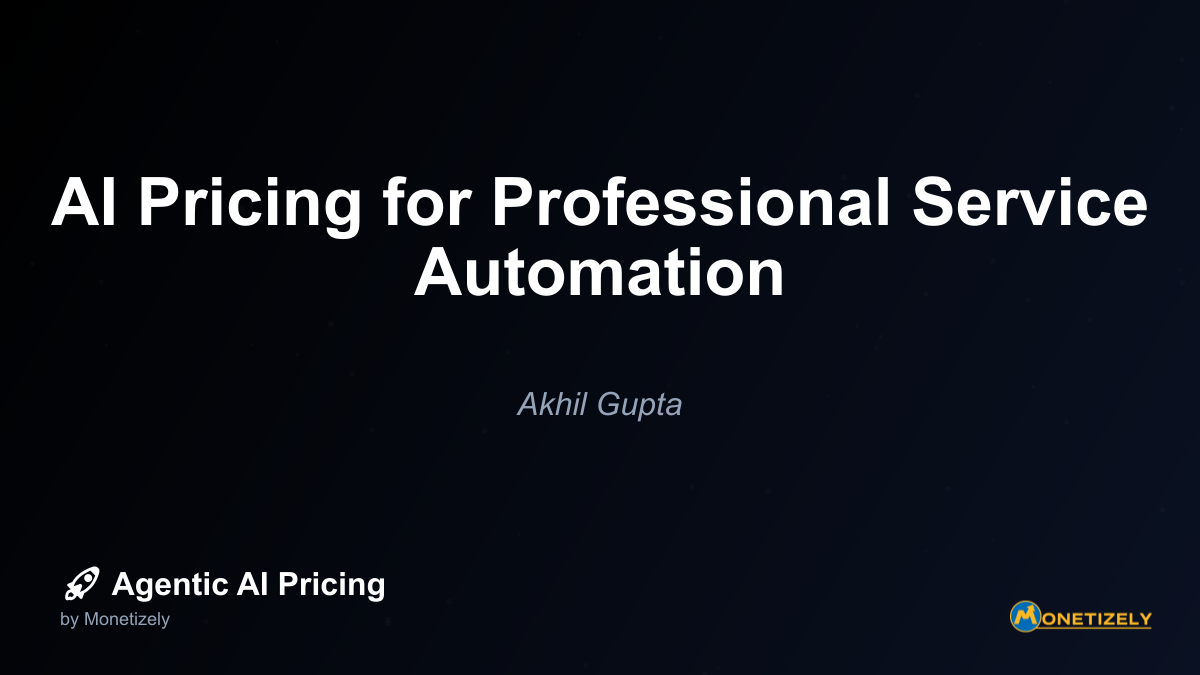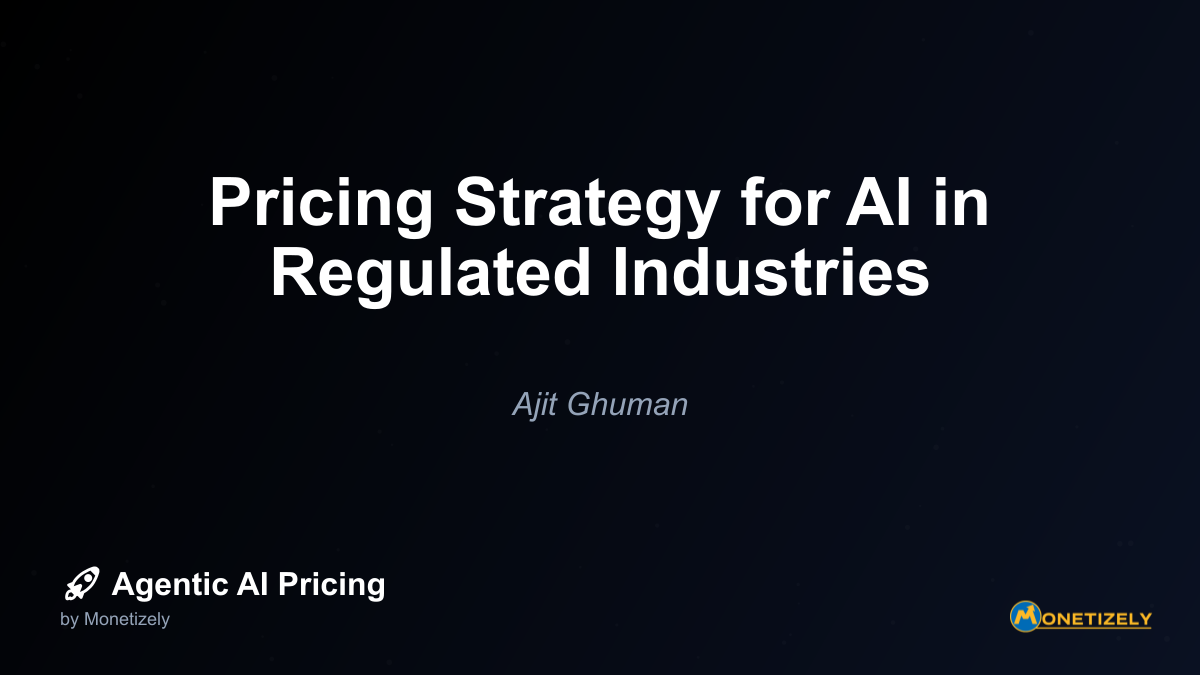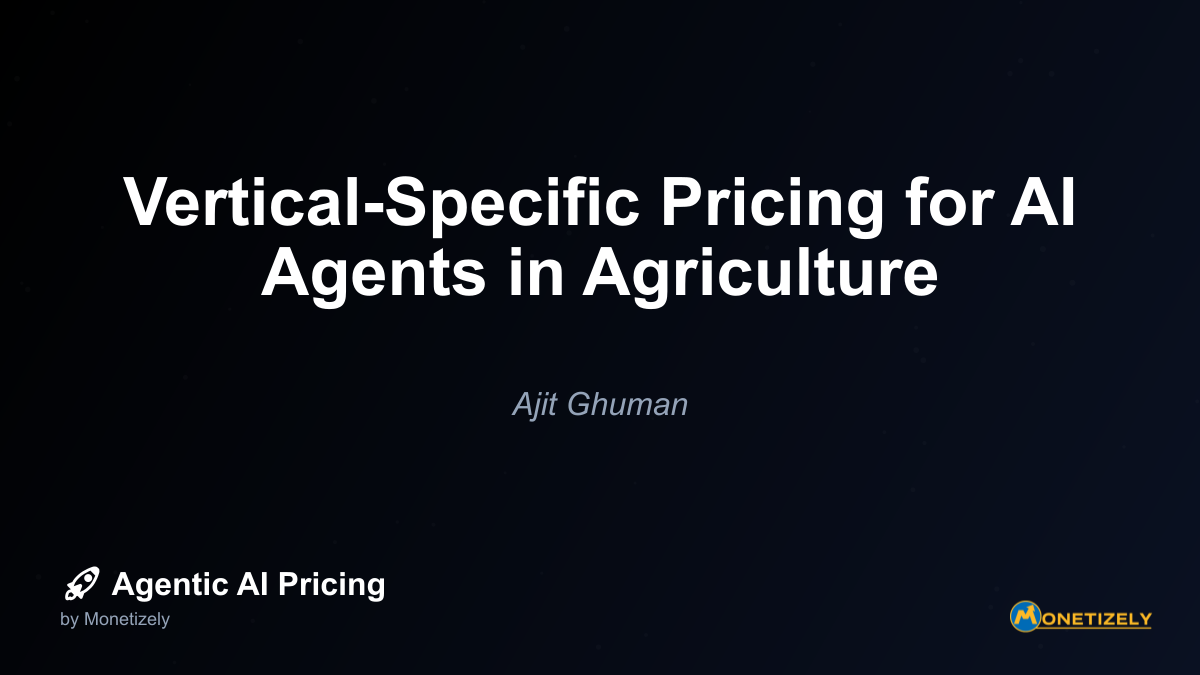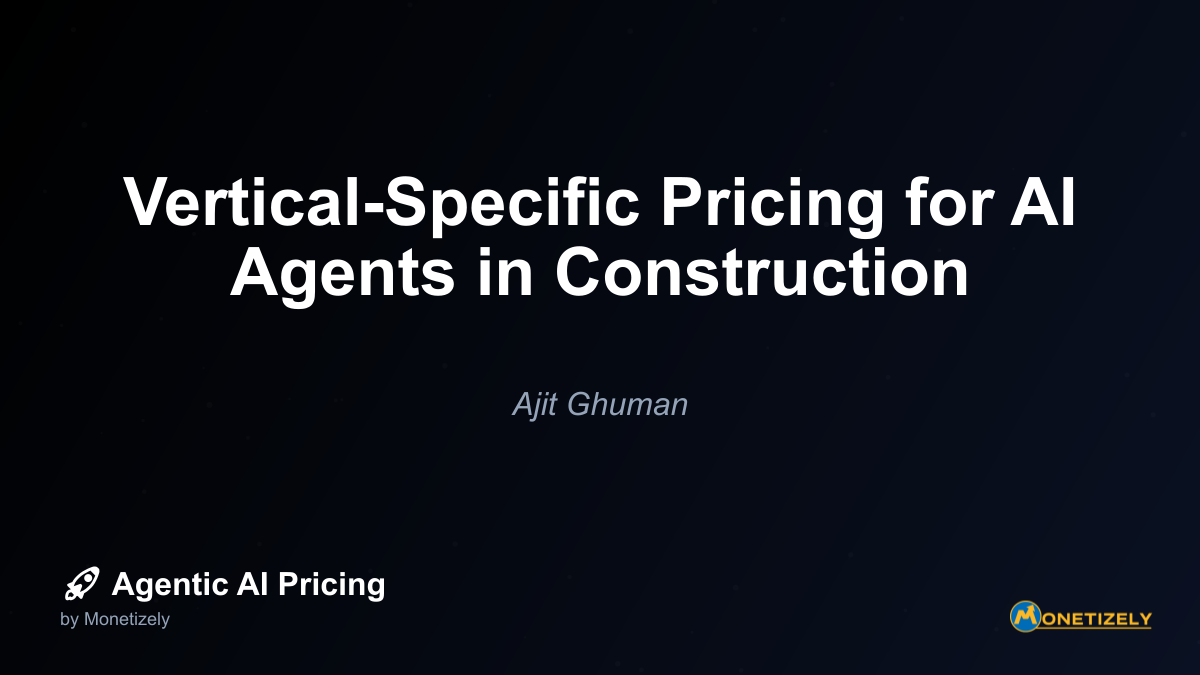· Ajit Ghuman · Industry-Specific · 12 min read
Vertical-Specific Pricing for AI Agents in Non-Profits
AI and SaaS Pricing Masterclass
Learn the art of strategic pricing directly from industry experts. Our comprehensive course provides frameworks and methodologies for optimizing your pricing strategy in the evolving AI landscape. Earn a professional certification that can be imported directly to your LinkedIn profile.
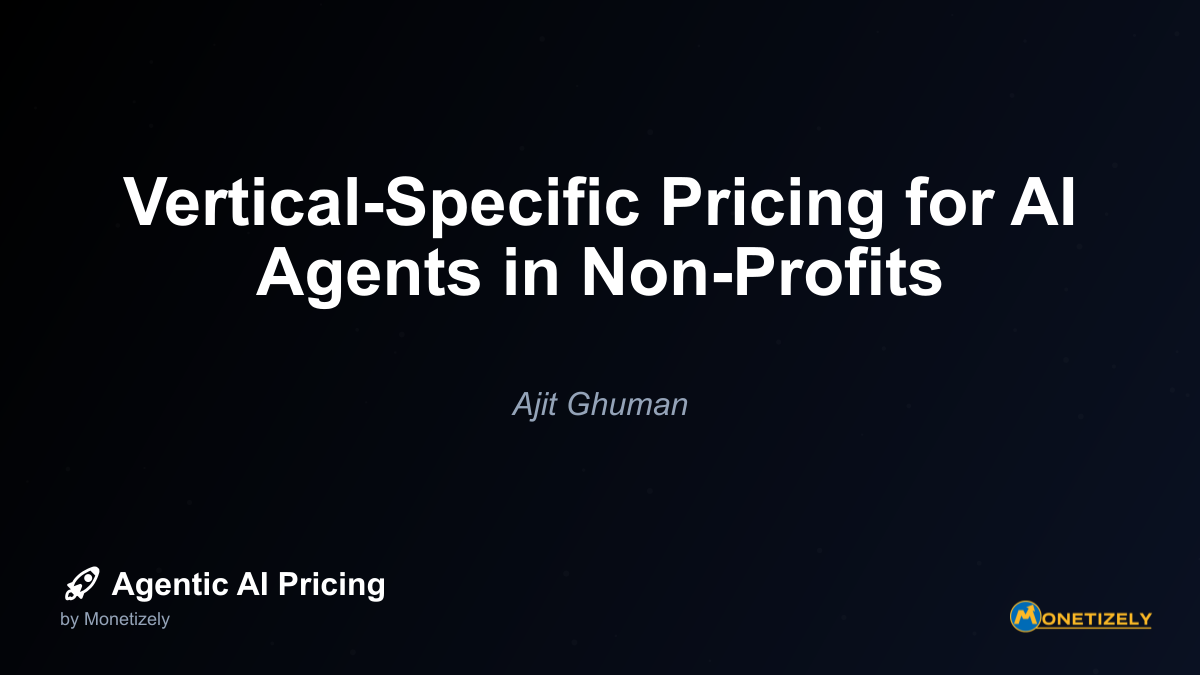
The non-profit sector stands at a critical juncture in its adoption of artificial intelligence. As mission-driven organizations seek to maximize impact while operating under resource constraints, the pricing and implementation of AI agents present unique challenges and opportunities. Unlike their for-profit counterparts, non-profits must balance technological advancement with ethical considerations, impact measurement, and alignment with their core missions. This comprehensive analysis explores the nuanced landscape of vertical-specific pricing for AI agents in the non-profit sector, offering strategic insights for decision-makers navigating this evolving terrain.
The Unique AI Pricing Landscape for Non-Profits
Non-profit organizations operate under fundamentally different constraints than commercial enterprises. Their mission-driven nature, reliance on grants and donations, and focus on social impact rather than profit margins create a distinct context for AI implementation and pricing considerations.
Current State of AI Adoption in Non-Profits (2023-2025)
The adoption of AI within the non-profit sector has accelerated significantly between 2023 and 2025, driven by increasing accessibility and demonstrated impact. Major AI providers have recognized the unique needs of this sector, with companies like OpenAI introducing specialized programs offering substantial discounts—ranging from 20% off standard ChatGPT subscriptions to 50% for large-scale deployments under initiatives like OpenAI for Nonprofits.
Despite these advances, adoption remains uneven across the sector. According to recent research, while 67% of non-profits acknowledge AI’s potential to transform their operations, only 23% report having formal AI implementation strategies in place. This gap highlights both the opportunity and the challenges facing the sector.
The primary barriers to adoption include:
- Limited budgets and uncertain ROI calculations
- Lack of technical expertise within existing staff
- Concerns about data privacy, security, and ethical implications
- Cultural resistance to automation in traditionally human-centered work
- Difficulty aligning AI capabilities with specific mission objectives
The Mission-Driven Pricing Paradigm
Traditional pricing models for technology solutions often fail to address the unique requirements of non-profit organizations. A mission-driven pricing paradigm considers several factors specific to this sector:
Value Alignment: Pricing must reflect the tool’s contribution to the organization’s social mission, not just operational efficiency.
Resource Constraints: Non-profits typically operate with fixed budgets and grant funding cycles that limit flexibility for ongoing technology investments.
Impact Measurement: The return on investment must be measured in terms of mission advancement and social outcomes, not just financial metrics.
Scalability Requirements: Solutions must be accessible to organizations of varying sizes, from grassroots initiatives to international NGOs.
As one non-profit technology director noted: “We’re not just looking for the cheapest option; we’re looking for solutions that understand our funding constraints while maximizing our impact potential.”
Strategic Pricing Models for Non-Profit AI Applications
The most effective pricing approaches for non-profit AI implementations vary based on the specific application area, organizational size, and impact goals. Here we examine the predominant models emerging in the sector.
Tiered Pricing Based on Organizational Size and Reach
Tiered pricing has emerged as a flexible approach that accommodates the diverse landscape of non-profit organizations. This model typically segments pricing based on:
- Annual operating budget
- Number of beneficiaries served
- Geographic scope (local, regional, national, international)
- Staff size and user requirements
For example, an AI-powered donor management platform might offer:
| Tier | Organization Size | Monthly Cost | Features |
|---|---|---|---|
| Starter | < $500K annual budget | $99 | Basic donor analytics, automated acknowledgments |
| Growth | $500K-$2M annual budget | $249 | Predictive donor scoring, personalized campaigns |
| Impact | $2M-$10M annual budget | $499 | Advanced segmentation, AI-driven fundraising strategy |
| Enterprise | > $10M annual budget | Custom | Full integration, dedicated AI strategy support |
This approach ensures accessibility for smaller organizations while providing sustainable revenue from larger entities that can afford more comprehensive solutions.
Usage-Based Models for Fluctuating Needs
Non-profits often experience cyclical patterns in their operations, with intensive periods around campaigns, grant deadlines, or seasonal programs. Usage-based pricing accommodates these fluctuations by charging based on:
- Number of AI queries or interactions
- Data processing volume
- Number of campaigns or projects
- Seasonal usage patterns
This model is particularly effective for:
- Fundraising campaigns with concentrated activity periods
- Research projects with variable data analysis needs
- Advocacy organizations with campaign-based operations
“Our grant writing intensity varies dramatically throughout the year,” explains a development director at a mid-sized educational non-profit. “A usage-based model for our AI grant writing assistant means we only pay for the capacity we need when we need it.”
Consortium Pricing for Collective Impact
A growing trend in the non-profit sector is the formation of technology consortiums—groups of organizations with similar missions that collectively negotiate and purchase AI solutions. This approach offers several advantages:
- Enhanced negotiating power through combined purchasing volume
- Shared implementation costs and technical expertise
- Collaborative learning and best practice development
- Aligned impact measurement frameworks
Consortium pricing is particularly effective for:
- Community-based organizations in specific geographic regions
- Non-profits working within the same cause area (e.g., homelessness, education)
- Networks of affiliated but independent organizations
A notable example is the Environmental Data Consortium, which negotiated a comprehensive AI analytics package for 27 environmental non-profits at a 43% discount compared to individual purchasing.
Grant-Aligned Subscription Models
Recognizing the funding realities of non-profits, some AI providers have developed subscription models specifically designed to align with grant funding cycles. These typically feature:
- Annual billing options that match grant disbursement schedules
- Flexible start/end dates that align with funding periods
- Documentation formatted for grant reporting requirements
- Impact measurement frameworks that satisfy funder expectations
This approach addresses one of the most significant challenges in non-profit technology adoption: the misalignment between traditional monthly SaaS billing and the annual or multi-year grant funding cycles that dominate non-profit budgeting.
Impact Measurement and ROI Frameworks for Non-Profit AI
Unlike commercial enterprises that measure AI ROI primarily through financial metrics, non-profits require more nuanced frameworks that capture their dual imperatives of operational efficiency and mission advancement.
The Return on Mission (ROM) Calculation
The concept of Return on Mission (ROM) has emerged as a critical framework for evaluating AI investments in the non-profit context. ROM encompasses:
- Efficiency Gains: How AI reduces administrative burden and operational costs
- Mission Amplification: How AI extends the organization’s reach and impact
- Stakeholder Value: How AI improves experiences for beneficiaries, donors, and staff
- Sustainability Impact: How AI contributes to long-term organizational resilience
A comprehensive ROM calculation might include metrics such as:
- Percentage of staff time redirected from administrative to mission-focused activities
- Increase in beneficiaries served per dollar spent
- Improvement in program outcomes attributable to AI-enhanced interventions
- Growth in donor engagement and retention rates through AI-powered personalization
Quantitative Impact Metrics for AI Implementation
While mission impact often involves qualitative assessment, non-profits are increasingly developing quantitative frameworks to measure AI’s contribution. Key metrics include:
Fundraising Effectiveness:
- Donor conversion rate improvements
- Average donation amount increases
- Donor retention rate changes
- Fundraising cost per dollar raised
- Grant application success rate
Operational Efficiency:
- Administrative hours saved through automation
- Error reduction in data processing
- Response time improvements for stakeholder inquiries
- Resource allocation optimization
- Compliance accuracy rates
Program Delivery:
- Beneficiary reach expansion
- Service delivery speed improvements
- Personalization effectiveness
- Intervention accuracy rates
- Predictive modeling success for program outcomes
Strategic Decision-Making:
- Data-informed decision speed
- Scenario analysis depth and accuracy
- Strategic pivot identification
- Risk assessment improvement
- Resource allocation optimization
Balancing Quantitative and Qualitative Impact Assessment
While quantitative metrics provide important benchmarks, the most effective non-profit AI evaluations combine these with qualitative assessment methods:
- Beneficiary experience surveys and interviews
- Staff satisfaction and empowerment measurements
- Case studies of transformative impact
- Narrative documentation of mission advancement
- Ethical assessment of AI implementation
“Numbers tell only part of the story,” notes the CEO of a large international development organization. “Our AI impact framework combines hard metrics with rich qualitative evidence of how these tools are changing lives on the ground.”
Grant Alignment Strategies for AI Implementation
Given the centrality of grant funding to non-profit operations, aligning AI initiatives with funding opportunities is crucial for sustainable implementation.
Positioning AI as a Capacity-Building Investment
Successful grant proposals for AI implementation typically position these technologies as strategic capacity-building investments rather than simply operational expenses. This framing emphasizes:
- Long-term efficiency gains that multiply the impact of other grant-funded activities
- Enhanced ability to measure and report program outcomes
- Increased organizational resilience and adaptability
- Improved service delivery to beneficiaries
- Strategic alignment with funders’ own digital transformation priorities
“We’ve had the most success when we position AI not as a technology expense but as a strategic multiplier that enhances everything else we do,” explains a chief strategy officer at a healthcare non-profit. “That resonates with funders looking for sustainable impact.”
Specific Grant Opportunities for Non-Profit AI (2024-2025)
The funding landscape for non-profit AI implementation has expanded considerably in recent years. Notable opportunities include:
Foundation Technology Grants:
- The Gates Foundation Digital Transformation Initiative
- MacArthur Foundation Technology in the Public Interest program
- Ford Foundation Digital Infrastructure grants
Corporate AI for Good Programs:
- Microsoft AI for Humanitarian Action
- Google.org Impact Challenge: AI for Social Good
- Salesforce.org Tech for Social Impact grants
Government Funding:
- National Science Foundation Civic Innovation Challenge
- Department of Health and Human Services Technology Innovation for the Underserved
- USAID Digital Development for Feed the Future
Collective Impact Funds:
- The Digital Civil Society Lab’s AI Governance grants
- NetHope’s AI for Development collaborative
- TechSoup’s AI Accelerator for Nonprofits
When applying for these opportunities, organizations should emphasize:
- Clear alignment between AI capabilities and specific program outcomes
- Concrete impact measurement methodologies
- Sustainability plans beyond the initial funding period
- Knowledge sharing commitments to benefit the broader sector
- Ethical frameworks for responsible AI implementation
Multi-Year Funding Strategies for Sustainable AI Adoption
Given the ongoing nature of AI implementation and evolution, non-profits are developing multi-year funding strategies that support sustainable adoption:
Phased Implementation Funding:
- Initial pilot phase with focused metrics and clear success criteria
- Scaling phase based on demonstrated pilot outcomes
- Integration phase embedding AI capabilities across programs
- Innovation phase exploring advanced applications
Diversified Funding Portfolio:
- Core technology infrastructure supported by capacity-building grants
- Ongoing operational costs integrated into program grants
- Innovation and expansion funded through dedicated technology initiatives
- Training and capability development through professional development funding
Collaborative Funding Approaches:
- Joint applications from multiple organizations with shared needs
- Pooled funding models where multiple funders contribute to a common AI infrastructure
- Technology partner matching programs where vendors provide in-kind support alongside grant funding
Vertical-Specific AI Applications and Pricing Considerations
Different segments of the non-profit sector have unique AI implementation needs and corresponding pricing considerations. Here we examine four key verticals and their distinct requirements.
International Development Organizations
International development organizations typically operate across multiple countries with diverse program portfolios and complex logistical challenges. Their AI applications often focus on:
- Predictive modeling for resource allocation and risk management
- Language translation and cross-cultural communication
- Remote monitoring and evaluation systems
- Supply chain and logistics optimization
- Data collection in low-connectivity environments
Pricing Considerations:
- Multi-currency and regional pricing adjustments
- Offline functionality requirements that may increase development costs
- Data sovereignty and localization compliance expenses
- Scaling across diverse operational contexts
- Integration with existing international development platforms
Case Study: Humanitarian Response Optimization
A leading international humanitarian organization implemented an AI-powered response optimization system that coordinates aid distribution across multiple crisis zones. The pricing model includes:
- Core platform license based on organizational budget tier
- Per-crisis activation fees that align with emergency funding mechanisms
- Data processing charges scaled to beneficiary numbers
- API integration fees for existing humanitarian coordination systems
- Training and capacity building components for local staff
This model aligns costs with the organization’s funding structure while ensuring the solution remains available during acute humanitarian crises when impact is most critical.
Healthcare Non-Profits
Healthcare-focused non-profits face unique regulatory requirements and sensitive data considerations while serving vulnerable populations. Their AI applications typically include:
- Patient risk stratification and early intervention identification
- Treatment protocol optimization and personalization
- Health worker support and decision assistance
- Remote monitoring and telehealth enablement
- Public health trend analysis and response planning
Pricing Considerations:
- HIPAA and other regulatory compliance requirements
- Higher security and privacy protection costs
- Integration with electronic health records and clinical systems
- Validation and certification expenses for clinical applications
- Liability and risk management considerations
Case Study: Community Health Worker AI Assistant
A non-profit focused on community health in underserved areas implemented an AI assistant that supports community health workers with diagnostic guidance, treatment protocols, and patient education. The pricing structure includes:
- Base platform fee scaled to number of health facilities
- Per-health worker licensing with volume discounts
- Offline functionality for low-connectivity areas
- Annual content updates for medical protocols
- Impact measurement and reporting system
The organization negotiated a “pay for outcomes” component where fees are partially tied to demonstrated health improvements, aligning the technology provider’s incentives with the non-profit’s mission outcomes.
Educational Non-Profits
Educational organizations leverage AI to extend their reach, personalize learning experiences, and measure learning outcomes more effectively. Common applications include:
- Personalized learning pathways and content adaptation
- Automated assessment and feedback systems
- Student engagement and retention prediction
- Educational resource curation and recommendation
- Learning outcome measurement and program evaluation
Pricing Considerations:
- Academic calendar alignment and seasonal usage patterns
- Student data privacy regulations and protections
- Accessibility requirements for diverse learners
- Integration with learning management systems
- Scaling from classroom to district to system levels
Case Study: Literacy Intervention AI
A national literacy-focused non-profit implemented an AI-powered reading intervention system that identifies struggling readers and provides personalized support. Their pricing arrangement features:
- School-based annual licensing aligned with academic years
- Tiered pricing based on student population and district resources
- Summer program reduced rates for continuous learning
- Professional development and teacher training components
- Impact measurement system tied to standardized reading assessments
The provider offers a “mission match” program where a percentage of fees from affluent districts subsidize implementation in under-resourced communities, aligning with the non-profit’s equity goals.
Advocacy and Policy Organizations
Advocacy organizations use AI to amplify their message, engage supporters more effectively, and analyze policy impacts. Key applications include:
- Public opinion analysis and message testing
- Supporter engagement personalization
- Policy impact simulation and prediction
- Legislative and regulatory monitoring
- Campaign optimization and resource allocation
Pricing Considerations:
- Campaign-based usage patterns with intensity spikes
- Integration with advocacy platforms and CRM systems
- Social media and public data analysis capabilities
- Rapid scaling requirements during active campaigns
- Coalition-based licensing for collaborative advocacy
Case Study: Environmental Advocacy Coalition
A coalition of environmental advocacy organizations implemented a shared AI system for campaign optimization and supporter engagement. The consortium pricing model includes:
- Base platform access for all coalition members
- Usage-based components for specific campaigns
- Shared data repository with privacy controls
- Collaborative learning system across organizations
- Collective impact measurement framework
This approach allows smaller advocacy organizations to access sophisticated AI capabilities through shared resources while enabling coordinated campaigns with consistent messaging and supporter engagement strategies.
Ethical Considerations in Non-Profit AI Pricing
The mission-driven nature of non-profits raises unique ethical considerations in AI pricing and implementation that go beyond those faced by commercial enterprises.
Accessibility and Equity in AI Pricing
Non-profits serve diverse communities, often including vulnerable and underrepresented populations. Ethical AI pricing must consider:
Financial Accessibility:
- Sliding scale pricing based on organizational capacity
- Subsidized access for organizations serving high-need communities
- Transparent pricing that allows for accurate budgeting and planning
- Flexible payment terms aligned with funding realities
Technical Accessibility:
- Solutions designed for varying levels of technical expertise
- Training and support included in pricing models
- Gradual implementation pathways for organizations with limited capacity
- Compatibility with existing systems and infrastructure
Equitable Impact:
- Pricing structures that don’t disadvantage smaller organizations
- Consortium options for collective bargaining power
- Knowledge sharing mechanisms across the sector
- Prevention of “AI haves and have-nots” within the non-profit ecosystem
“The last thing we want is for AI to become another dividing line between well-resourced non-profits and those serving the most marginalized communities,” notes a technology equity advocate. “Pricing models must be designed with this risk in mind.”
Data Ownership and Privacy Considerations
Non-profits often work with sensitive data from vulnerable populations, raising critical questions about data usage in AI systems:
Data Rights in Pricing Agreements:
- Clear ownership of data generated within AI systems
- Limitations on vendor usage of non-profit data for model training
- Data portability guarantees if changing providers
- Transparency around data processing and storage locations
Beneficiary Privacy Protection:
- Specific provisions for handling sensitive personal information
- Compliance with relevant regulations (GDPR, CCPA, etc.)
- Anonymization and aggregation requirements
- Informed consent frameworks for AI data usage
Ethical Data Usage:
Co-Founder & CEO
Ajit is the author of Price To Scale, a top book on SaaS Pricing and is the Founder of Monetizely. Ajit has led and worked in pricing and product marketing at firms like Twilio, Narvar and Medallia. His work has been featured in Forbes and VentureBeat. Ajit regularly consults with software companies from Seed stage to post-IPO on pricing strategy. Ajit is also a highly-rated co-instructor for 'The Art of SaaS Pricing and Monetization' on Maven.
Pricing Strategy Audit
Let our experts analyze your current pricing strategy and identify opportunities for improvement. Our data-driven assessment will help you unlock untapped revenue potential and optimize your AI pricing approach.

